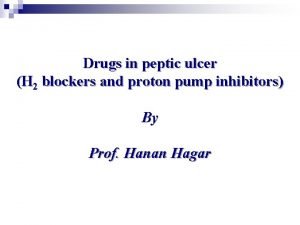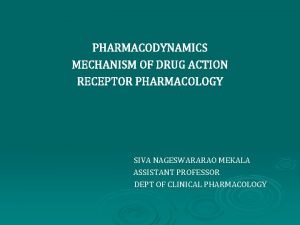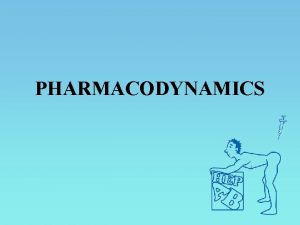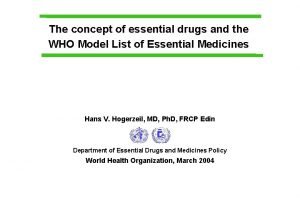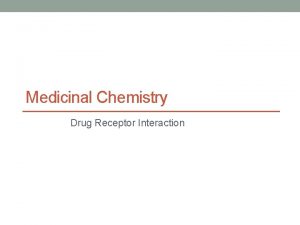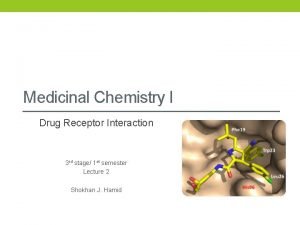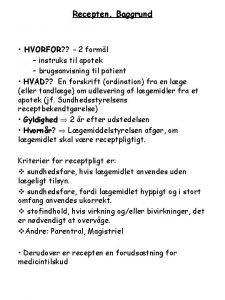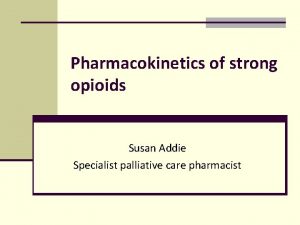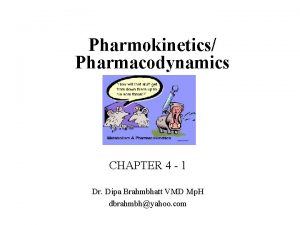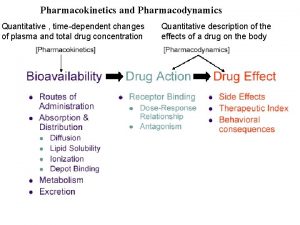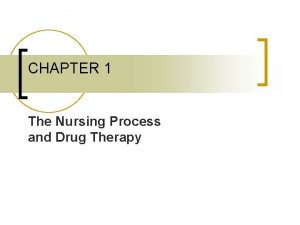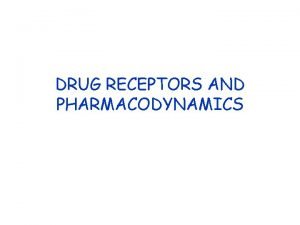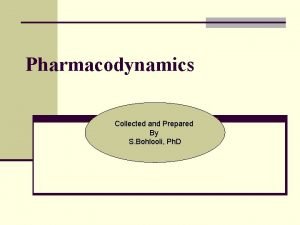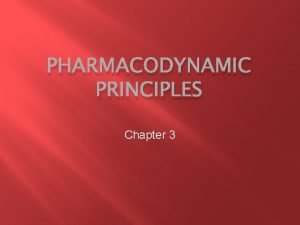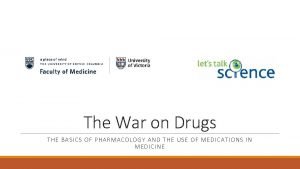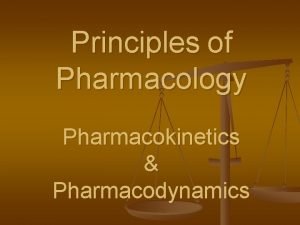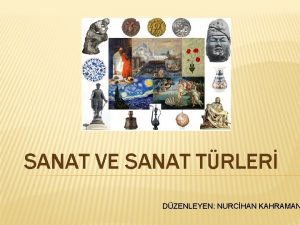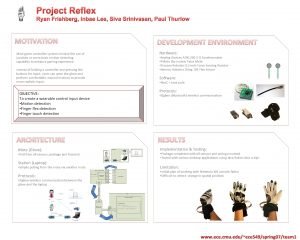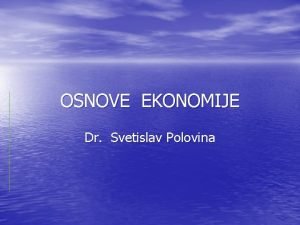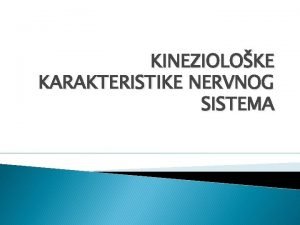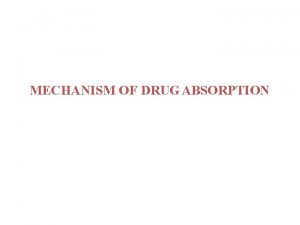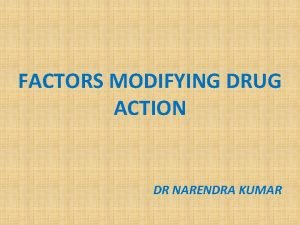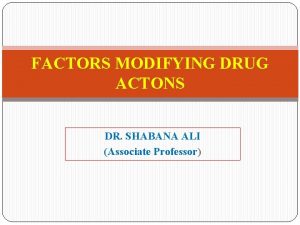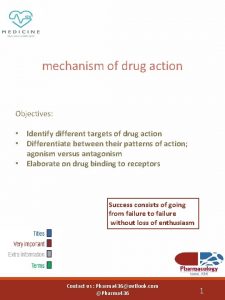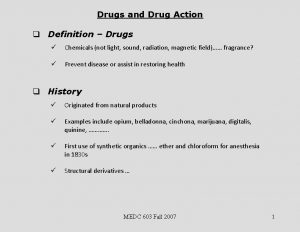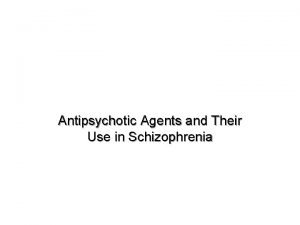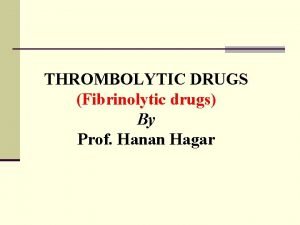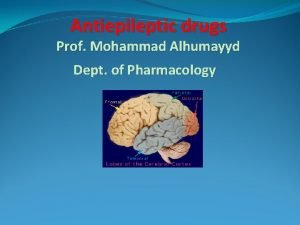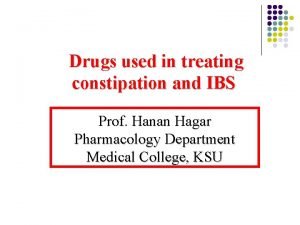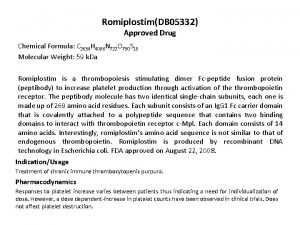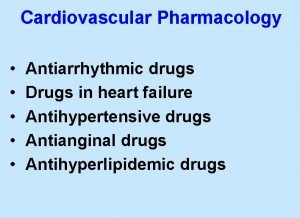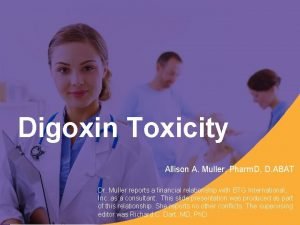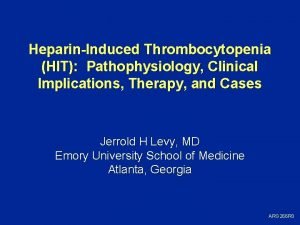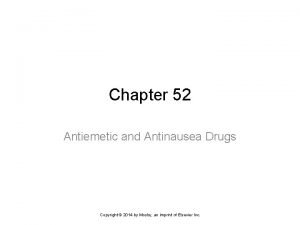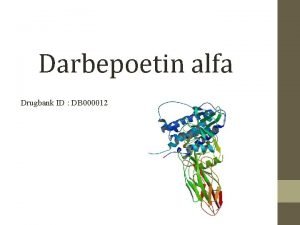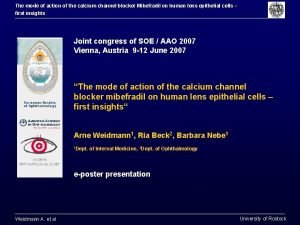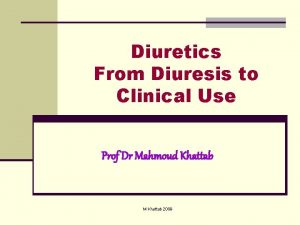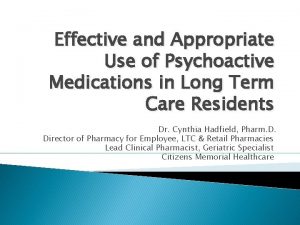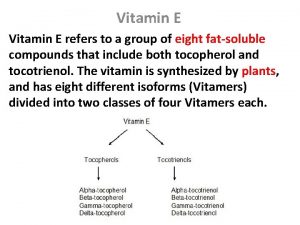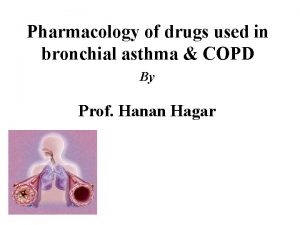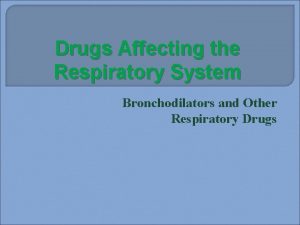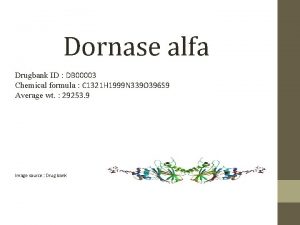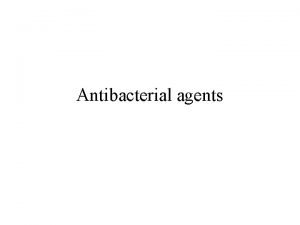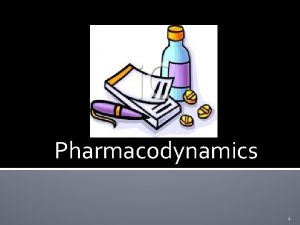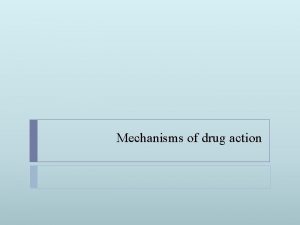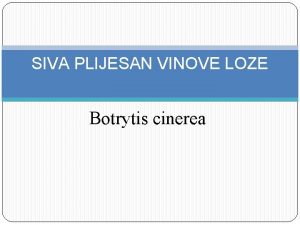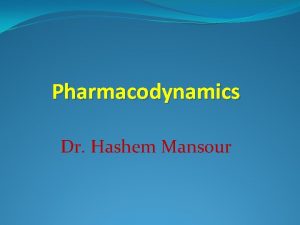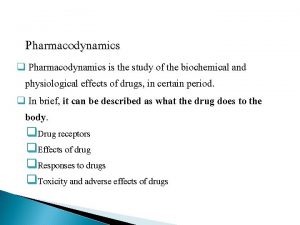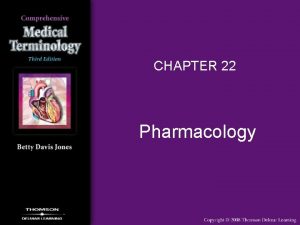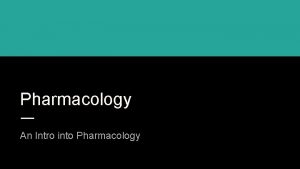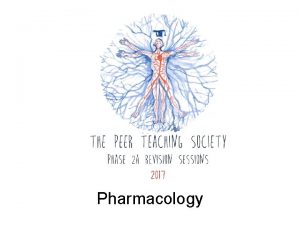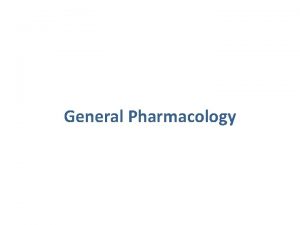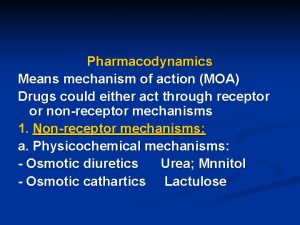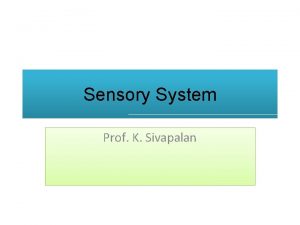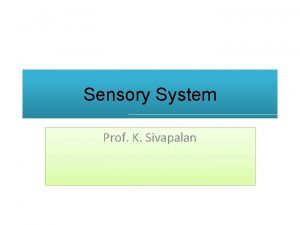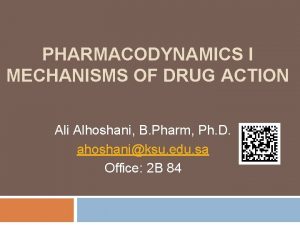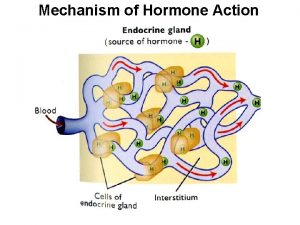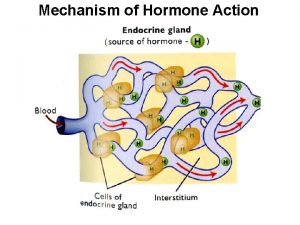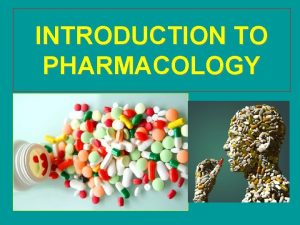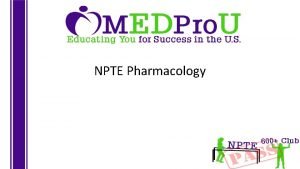PHARMACODYNAMICS MECHANISM OF DRUG ACTION RECEPTOR PHARMACOLOGY SIVA





















































- Slides: 53

PHARMACODYNAMICS MECHANISM OF DRUG ACTION RECEPTOR PHARMACOLOGY SIVA NAGESWARARAO MEKALA ASSISTANT PROFESSOR DEPT OF CLINICAL PHARMACOLOGY

Pharmacon : Drug , Dynamics : Power Ø Pharmacodynamics is the study of drug effects Ø It attempts to explain the complete action effect sequence and the dose effect relationship Ø Modification of the action of one drug by another drug is also an aspect of pharmacodynamics Ø Explain about MOA, PA & ADR

Site of drug action: Ø Extracellular drug action : Antacids neutralizing gastric acidity Chelating agents forming complexes with heavy metals Ø Cellular site of drug action : Action of Ach on nicotinic receptors of motor end plate , leading to contraction of skeletal muscle Ø Intracellular site of drug action: Trimethoprim or sulfa drugs act by interfering with the synthesis of folic acid which is an intracellular component

Ø PRINCIPLES /TYPES OF DRUG ACTION: Ø Drugs do not impart any new functions to any system, organ or cell; they only alter the pace of ongoing activity The basic types of drug action can be broadly classed as Ø 1. Stimulation: some drugs act by increasing the of activity of specialized cells e. g. adrenaline stimulates heart resulting increasing heart rate. pilocarpine stimulates salivary glands. Ø 2. Depression : some drugs act by decreasing the of activity of specialized cells Eg: Alcohol , barbiturates , General anesthetics depress the central nervous system Quinidine depresses heart

Ø 3. Irritation: Certain agents on topical application cause irritation of the skin and adjacent tissues. By such action , they can produce local and remote effect s. ü ü ü Ø Reflexly increasing local circulation in deeper structures Blocking impulse conduction in the spinal cord Placebo effect. Eg: Eucalyptus oil , Methyl salicylate etc 4. Replacement : When there is a deficiency of endogenous substances , they e. g. levodopa in parkinsonism, insulin in diabetes mellitus, iron in anaemia

5. Cytotoxic action: Selective cytotoxic action for invading parasites or cancer cells, attenuating them without significantly affecting host cells is utilized for cure/palliation of infections and neoplasms e. g. penicillin, chloroquine, zidovudine, mustine

MECHANISM OF DRUG ACTION: v Non –Receptor mediated mechanisms v Receptor mediated mechanism

v Non –Receptor mediated mechanisms : 1) By physical action : Ø Osmosis : Some drugs act by excreting an osmotic effect Eg: 20% mannitol in cerebral oedema and congestive glaucoma Ø Adsorption: Activated charcoal adsorbs toxins , hence it is used in the treatment of drug poisoning. Ø Demulcent : Cough syrup produces a soothing effect in pharyngitis by coating the inflamed mucosa

Ø Radioactivity : Radioactive isotopes emit rays and destroy the tissues Eg: 131 I in hyperthyroidism 2) By chemical action : Antacids are weak bases , hence they neutralize acid in the stomach Ø Metals like iron , copper , Mercury etc are eliminated from the body with the help of chelating agents. They trap the metals in their ring structure and form water soluble complexes , which are rapidly excreted from the body. Ø Eg: Dimercaprol in arsenic poisoning d-penicillamine in copper poisoning

3) Through enzymes: Some drugs act either by activating or inhibiting the enzyme activity. A) Drug action via enzyme inhibition : ü ACE inhibitors such as captopril , Enalapril etc act by inhibiting angiotensin converting enzyme. Hence they are used in the treatment of Hypertension and CHF ü Xanthine and hypoxanthine are oxidized to uric acid by the enzyme xanthine oxidase , which is inhibited by allopurinol. Allopurinol is used in the treatment of chronic gout to reduce the synthesis of the uric acid ü Disulphiram inhibits aldehyde dehydrogenase enzyme and is used in the treatment of chronic alcoholism (accumulation of acetaldehyde in blood and tissues )

Ø B) Drug action by activation of enzymes: Pralidoxime reactivates cholinesterases and is used in organpophosphorous poisoning 4) Drugs acting through antibody production : Vaccines produce their effect by stimulating the formation of antibodies. Eg: Vaccines against tuberculosis (BCG), Oral polio vaccine etc

5) Placebo effect: Placebo is a latin word that means “I WILL PLEASE “. It is a dummy medicine having no pharmacological activity. The effect produced by placebo called placebo effect. Uses: Ø Placebos are used for the relief of subjective symptoms like anxiety , headache , tremors , pain , insomnia etc Ø Placebos are used in clinical trials in order to minimize bias

Factors affecting placebo effect are : Ø Patient factor : patients with neurotic symptoms often respond to placebos Ø Drug factor: the placebo response can be affected by the presentation or route of administration of the drug. For example colorful tablets such as red , blue , green etc preparations give better placebo effect. Ø Doctor factor : Ø Personality of the doctor , motivation , way of instruction , doctor – patient relationship etc are important factors that also affect the response to placebo.

Receptor mediated mechanisms: Ø Receptors are macromolecules , present either on the cell surface , cytoplasm or in the nucleus where the drug binds and interacts to produce cellular changes. but itself has no other function Ø Receptors are proteins and have specificity and selectivity. Drug (D) + Receptor (R) Drug –receptor complex Response

The following terms are used in describing drug-receptor interaction Ø Affinity : The ability of the drug to get bound to the receptor is known as affinity. Ø Intrinsic activity : The ability of the drug to produce a pharmacological action after combining with the receptor is known as intrinsic activity of the drug. Ø Agonist: A drug that is capable of producing pharmacological action after binding to the receptor High affinity + high intrinsic activity (Eg: Morphine , Adrenaline )

Ø Inverse agonist: It has full affinity towards the receptor but produces effect just opposite to that of an agonist. Eg: Benzodiazepines produce antianxiety and anticonvulsant effects by interacting with its receptors , But β-Carbolines act as inverse agonist at benzodiazepine receptor and produce anxiety and convulsions. Affinity + intrinsic activity : 0 to -1 Ø Partial agonist: Drug that has affinity to the receptor but less intrinsic activity Affinity +less intrinsic activity (eg: Pindolol , Buprenorphine)

Ø Antagonist: Drugs that bind to receptors but are not capable of producing pharmacological action. Antagonists have only affinity but no intrinsic activity. They produce receptor blockade. High affinity without intrinsic activity –naloxone , Atropine Ø Ligand: Any molecule which attaches selectively to particular receptors or sites The term only indicates affinity or binding without regard to functional change Agonists and antagonists are both ligands of the same receptor The overall scheme of action through receptors is depicted below


TRANSDUCER MECHANISMS: Ø The transducer mechanisms can be grouped into 4 major categories 1. G-protein coupled receptors (Metabotropic receptors ) 2. Receptors with intrinsic ion channel (inotropic receptors) 3. Enzyme–linked receptors 4. Receptors regulating gene expression (Transcription factors) or nuclear receptors

1. G-protein coupled receptors Ø These are large family of cell membrane receptors which are linked to the effector (enzyme/channel/carrier protein) through one or more GTP activated proteins (G-proteins) for response effectuation. Ø The molecule has 7 α-helical membrane spanning hydrophobic amino acid segments which run into 3 extracellular and 3 intracellular loops Ø The agonist binding site is located somewhere between the helices on the extracellular face, while another recognition site formed by cytosolic segments binds the coupling G-protein.

Ø The G-proteins float in the membrane with their exposed domain lying in the cytosol, and are heterotrimetric in composition (α, β and γ subunits) Ø In inactive state GDP is bound to their exposed domain, activation through the receptor leads to displacement of GDP by GTP Ø The active α-subunit carrying GTP dissociates from the other two subunits and either activates or inhibits the effector Ø The βγ subunits have also been shown to modulate certain effectors like receptor operated K+ channels, adenyl cyclase and phospholipase C Ø There are three major effector pathways through which G-protein coupled receptors function (a) Adenylcyclase: c. AMP pathway, (2)Phospholipase C: IP 3 -DAG pathway, (3) Channel regulation



The Calcium –phasphoinositide signaling pathway

2. Receptors with intrinsic ion channel Ø These cell surface receptors, also called ligand gated ion channels, enclose ion selective channels (for Na+, K+, Ca 2+ or Cl-) within their molecules. Ø Agonistic binding opens the channel and causes depolarization/hyperpolarization/changes in cytosolic ionic composition, depending on the ion that flows through Ø The nicotinic, cholinergic, GABA-A, glycine (inhibitory), excitatory AA (kainate, or N-methyl-D-aspartate, quisqualate) and 5 HT 3 receptors fall in this category Ø In these receptors, agonists directly operate ion channels, without the intervention of any coupling protein or second messenger


3. Enzyme–linked receptors: Ø This class of receptors have a subunit with enzymatic property or bind a JAK (Janus-Kinase) enzyme on activation Ø The agonist binding site and the catalytic site lie respectively on the outer and inner face of the plasma membrane Ø These two domains are interconnected through a single transmembrane stretch of peptide chain There are two major subgroups of such receptors : Ø (a) Those that have intrinsic enzymatic activity, e. g. insulin Ø (b) Those that lack intrinsic enzymatic activity, e. g. cytokines, growth hormone, interferons


4. Receptors regulating gene expression Ø In contrast to the above 3 classes of receptors, these are intracellular (cytoplasmic or nuclear) soluble proteins which respond to lipid soluble chemical messengers that penetrate the cell Ø The receptor protein (specific for each hormone/regulator) is inherently capable of binding to specific genes, but is kept inhibited till the hormone binds near its carboxy terminus and exposes the DNA binding regulatory segment located in the middle of the molecule Ø Attachment of the receptor protein to the genes facilitates their expression so that specific m. RNA is synthesized on the template of the gene

Ø This m. RNA moves to the ribosomes and directs synthesis of specific proteins which regulate the activity of target cells Ø All steroid hormones (glucocorticoids, mineralocorticoids, androgens, estrogens, progesterone), thyroxine, vit D and vit A function in this manner Ø Different steroidal hormones affect different target cells and produce different effects because each one binds to its own receptor and directs a unique pattern of synthesis of specific proteins


Functions of receptors: These can be summarized as Ø To propagate regulatory signals from outside to within the effector cell when the molecular species carrying the signal cannot itself penetrate the membrane Ø To amplify the signal Ø To integrate various extracellular and intracellular regulatory signals Ø And to maintain homeostasis

Regulation of receptors : Receptor down regulation Prolonged use of agonists Receptor up regulation prolonged use of antagonists Receptor number and sensitivity of the receptor Drug effect Eg: Chronic use of salbutamol Down regulates the beta-2 adrenoceptors , which may be responsible for decreased effect of salbutamol seen in asthmatics Drug effect Eg: when propranolol is stopped after prolonged use , some patients experience withdrawal syndrome such as anxiety , palpitation, tachycardia , rise BP etc. This is due to up regulation or super sensitivity of the receptors

Drug potency and efficacy : Drug potency : The quantity of a drug required to produce a desired response is potency of the drug. The lower the dose required for a given response , the more potent is the drug. 10 mg of morphine = 100 mg of pethidine, morphine is ten times more potent than pethidine A: Morphine B: Pethidine

Drug efficacy : It is the maximum effect of a drug. Morphine produces a degree of analgesia not obtainable with any dose of aspirin – morphine is more efficacious than aspirin A: Morphine B: Aspirin

Therapeutic window : with certain drugs , therapeutic effect is seen only over a narrow range of plasma drug concentration. Both below and above this range , beneficial effects are less. Eg: Tricyclic antidepressants , clonidine etc

Dose –response relationships The pharmacological effect of a drug depends on its concentration at the site of action, which in turn is determined by the dose of the drug administered. Such response is called “dose response relationship. Types: 1) Graded dose - response : ü This curve obtained by administering increasing amounts of drug to a single subject when the doses are plotted against the per cent response. ü if the dose is increased the magnitude of the response also increases until a stage comes when a further increase in the dose elicits no further increase in the effect.

Ø The response at this stage is called as the “Maximal response (MR)“ or ceiling response while the corresponding dose is called as the maximal dose (MD) or ceiling dose. Ø This curve when plotted on a graph takes the form of a rectangular hyperbola.

Log dose response curve : Ø On the logarithmic scale the curve is sigmoid shape.

Advantages: Ø From the middle portion of the curve(linear segment) ED 50 can be Calculated which can provide 50% of the maximal response. Ø LDR curves also helps differentiate between the relative potency and relative efficacy of the drug Ø A wide range of drug doses can be easily displayed on a graph Ø Comparison between agonists and study of antagonists become easier

Quantal dose response curve Ø Certain pharmacological effects which cannot be quantified but can only be said to be present or absent are called as quantal responses. Eg: drugs causing vomiting , ovulation

Therapeutic index(TI): is an index of drug safety It is the ratio of median lethal dose to the median effective dose TI : Median lethal dose (LD 50) …………………. . . . Median effective dose(ED 50) LD 50 : It is the dose of a drug required to kill 50% of the unlimited animal population ED 50: It is the dose of the drug which produces desired effect in 50% of the population Wider the value of TI , Safer is the drug. Eg: Penicillin has a high TI. Digoxin , lithium , Phenytoin have narrow TI.

Distance between ED 50 and LD 50 indicates safety margin

COMBINED EFFECT OF DRUGS: Ø When two or more drugs are given simultaneously or in quick succession, they may be either indifferent to each other or exhibit synergism or antagonism Ø SYNERGISM : (Greek: Syn-together ; ergon-work) Ø When the action of one drug is facilitated or increased by the other, they are said to be synergistic Ø In a synergistic pair, both the drugs can have action in the same direction or given alone may be inactive but still enhance the action of the other when given together

Ø Synergism can be additive or supra additive (a) Additive: The effects of the two drugs is in the same direction and simply adds up: Ø Effect of drugs A+B = effect of drug A + effect of drug B Additive drug combinations: Aspirin + paracetamol Ø Nitrous oxide + halothane Ø Amlodipine + atenolol Ø Glibenclamide + metformin Ø Ø Ephedrine + theophylline As analgesic/antipyretic As general anaesthetic As antihypertensive As hypoglycaemic As bronchodilator Side effects of the components of an additive pair may be different – Do not add up Ø This combination is better tolerated than higher dose of one component Ø

(b) Supraadditive (potentiation): The effect of combination is greater than the individual effects of the components Effect of drug A + B > effect of drug A + effect of drug B Ø This is always the case when one component is inactive as such Ø Supraadditive drug combinations: Drug pair Ø Ø Acetylcholine + physostigmine Levodopa/carbidopa/ benserazide Adrenaline + cocaine/ desipramine Sulfamethoxazole + trimethoprim Basis of potentiation Inhibition of breakdown Inhibition of peripheral metabolism Inhibition of neuronal uptake Sequential blockade

Ø ANTAGONISM: When one drug decreases or abolishes the action of another, they are said to be antagonistic Effect of drugs A + B < effect of drug A + effect of drug B Ø Usually in an antagonistic pair one drug is inactive as such but decreases the effect of the other Ø Depending on the mechanism involved, antagonism may be Ø (A) PHYSICAL ANTAGONISM: Based on the physical property of the drugs, e. g. charcoal adsorbs alkaloids and can prevent their absorption – used in alkaloidal poisonings

Ø (B) CHEMICAL ANTAGONISM: The two drugs react chemically and form an inactive product, e. g. KMn. O 4 oxidizes alkaloids – used for gastric lavage in poisoning Ø Tannins + alkaloids – insoluble alkaloidal tannate is formed Ø Chelating agents (BAL, Calcium disodium edetate) – complex toxic metals (arsenic, lead) Ø Nitrites form methaemoglobin which reacts with cyanide radical – used in cyanide poisoning Ø

Ø (C) PHYSIOLOGICAL/FUNCTIONAL ANTAGONISM: Ø The two drugs act on different receptors or by different mechanisms , Ø But have opposite overt effects on the same physiological function, i. e. have pharmacological effects in opposite direction, e. g. Ø Histamine and adrenaline on bronchial muscle and BP Ø Hydrochlorothiazide and triamterene on urinary K+ excretion Ø Glucagon and insulin on blood sugar level

Ø (D) RECEPTOR ANTAGONISM: The antagonists binds to the same receptor as the agonist and inhibits effects. Ø This is a very important mechanism of drug action, because physiological signal molecules act through their receptors, blockade of which produce specific and often profound pharmacological effects Ø Receptor antagonists are selective (relatively), i. e. an anticholinergic will oppose contraction of intestinal smooth muscle induced by cholinergic agonists, but not that induced by histamine or 5 -HT It can be competitive or non competitive type

Competitive antagonists : Both antagonists and agonist reversibly to the same site of the receptor. Acetylcholine Muscarinic receptors Atropine (Agonist ) (Antagonists) Ø The competitive antagonism can be overcome by increasing the concentration of the agonist

NON – COMPETETIVE ANTAGONISM: The antagonist binds to a different site or to the same site with higher affinity so that the cannot displace it from the receptor. Eg: Phenoxybenzamine (Antagonist) and noradrenaline(agonist) bind to the same site on alfa adrenergic receptors. In this type , the antagonistic effect cannot be overcome by increasing the concentration of the agonist.

THANK YOU
 Gynecomasteia
Gynecomasteia Mechanism of drug action
Mechanism of drug action Difference between tolerance and tachyphylaxis
Difference between tolerance and tachyphylaxis Essential drug concept in pharmacology
Essential drug concept in pharmacology Drug-receptor interaction
Drug-receptor interaction Drug receptor interaction medicinal chemistry
Drug receptor interaction medicinal chemistry Recepten
Recepten Difference between pharmacodynamics and pharmacokinetics
Difference between pharmacodynamics and pharmacokinetics Pharmokinetics
Pharmokinetics Pharmacokinetics vs pharmacodynamics
Pharmacokinetics vs pharmacodynamics Define pharmacodynamics
Define pharmacodynamics Quantal dose
Quantal dose Iontropic
Iontropic Pharmacodynamics
Pharmacodynamics Pharmacodynamics
Pharmacodynamics Difference between pharmacodynamics and pharmacokinetics
Difference between pharmacodynamics and pharmacokinetics Example of crude drug adulterated with exhausted drug
Example of crude drug adulterated with exhausted drug Siva de scalzo
Siva de scalzo Yaş sıva üzerinde boyalarla yapılan renkli duvar resmi
Yaş sıva üzerinde boyalarla yapılan renkli duvar resmi Ryan hendrixson
Ryan hendrixson Indus river valley art
Indus river valley art Sveta knjiga hinduizma
Sveta knjiga hinduizma Siva ekonomija u srbiji
Siva ekonomija u srbiji Siva ekonomija definicija
Siva ekonomija definicija Rombasti mozak
Rombasti mozak Drug absorption mechanism
Drug absorption mechanism Factors modifying drug action
Factors modifying drug action Factors modifying drug action
Factors modifying drug action Drug action definition
Drug action definition Drugs definition
Drugs definition Phenytoin mechanism of action
Phenytoin mechanism of action Risperidone mechanism of action
Risperidone mechanism of action Thrombolytic drugs mechanism of action
Thrombolytic drugs mechanism of action Tumor treating fields mechanism of action
Tumor treating fields mechanism of action Phenytoin mechanism of action
Phenytoin mechanism of action Lactulose mechanism of action
Lactulose mechanism of action Nplate mechanism of action
Nplate mechanism of action Amiodarone mechanism of action
Amiodarone mechanism of action Digoxin mechanism
Digoxin mechanism Mechanism of action of bivalirudin
Mechanism of action of bivalirudin Anticholinergic drugs mechanism of action
Anticholinergic drugs mechanism of action Aranesp mechanism of action
Aranesp mechanism of action Mechanism of action of calcium channel blocker
Mechanism of action of calcium channel blocker Sidagliptin
Sidagliptin Potassium sparing diuretics mechanism of action
Potassium sparing diuretics mechanism of action Alloperidone
Alloperidone Vitamin e mechanism of action
Vitamin e mechanism of action Chemoreceptor trigger zone
Chemoreceptor trigger zone Theophylline mechanism of action
Theophylline mechanism of action Tiotropium mechanism of action
Tiotropium mechanism of action Pulmozyme mechanism of action
Pulmozyme mechanism of action Norflxacin
Norflxacin Capsofungin
Capsofungin Bisoprolol mechanism of action
Bisoprolol mechanism of action
